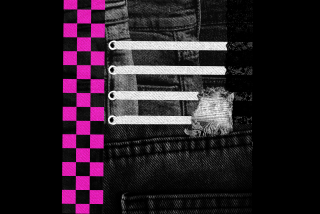A History Denied : Students Meet to Illuminate the Black Experience
RESEDA â Their classroom assignment took them back to Egypt, AD 1324, when West African ruler Mansa Musa traveled through North Africa leading thousands on a pilgrimage to Mecca.
The students were to imagine themselves as modern-day reporters transported to ancient Cairo and write a story about the event.
âHe had 500 slaves with him, and each one carried golden staffs weighing six pounds,â said a student who summarized the pilgrimage for her group.
âWhy?â another student asked about Musaâs extravagance.
âBecause he wanted to travel in class! He was the man.â
Such was another exuberant meeting of a group of seventh- and eighth-graders at the Sherman Oaks Center for Enriched Studies, where students have been gathering for two hours after school once a week since mid-March. Their goal: to learn black history--a subject they say theyâre not sufficiently taught in their regular history classes.
âWe went through a little bit of Malcolm X and the Black Panthers, but basically, African-American history really isnât focused on,â said Niamah Adams, an eighth-grader and member of the study group.
Even though the magnet school has a diverse student population composed of Latinos, whites, African Americans and immigrant students from countries throughout the world, the school continues, like most others, to teach both American and world history from a Eurocentric perspective, said students and teachers.
Educators maintain that such teaching perpetuates lies and half-truths.
âHistory, warts and flowers and all, needs to be told truthfully,â said James E. Turner, professor of African American studies and political sociology at Cornell University. âA national denial about critical parts of history is constantly being passed on to children.â
Itâs an old complaint among minority students and teachers. But at the Center for Enriched Studies, students and teachers have resolved to do something about it.
At about the same time the students began meeting, a group of eight teachers formed the Multicultural Awareness Coalition. Their first project is to create a resource center made up of clothing, books, pictures, flags and any item donated by students that represent their culture.
Coalition chairman and history teacher Greg Delahoussaye hopes that teachers will borrow the items and display them in class.
âWe want to make all the students feel that theyâre represented and theyâre important,â Delahoussaye said.
So far, Delahoussaye has received a shirt from Nigeria, books about Africa, a sombrero and one particularly unlikely exhibit.
âOne young man brought me pupusas from El Salvador. He said, âI want to bring this for you so you can know me a little better,â â Delahoussaye said.
But at a recent faculty training session where attempts were made to present a multicultural approach to teaching, some teachers reacted negatively to the idea.
âThere were a few who, from my perspective, werenât pleased with what was going on,â Delahoussaye said.
At the meeting, Delahoussaye said, he ended up challenging a lecturer invited by the school. The Middle Eastern woman remarked that Egypt was in the Middle East, not Africa.
âWhen the meeting was over, I quietly told her that there is a different perspective,â Delahoussaye said.
The Los Angeles Unified School District mandates that history be taught from a multicultural perspective, but district officials say they lack the funds to retrain teachers and buy textbooks and other materials.
The students in the after-school group say they arenât waiting on the district. Many are members of the African American Student Union who last year asked their faculty adviser, Lisa Lewis, if they could have a study group during their lunch hour. After a few sessions, Lewis challenged them to meet for two hours after school, where real learning could take place.
Teaching from textbooks and workbooks seldom used in public schools--books like â1999 Facts About Blacks: A Sourcebook of African American Accomplishmentâ--Lewis assigns homework and quizzes the students during each session.
Lewis said that the schoolâs student body, made up of fourth- through 12th-graders, provides her with a unique opportunity to work with various age groups. Though composed of seventh- and eighth-graders now, the group has included older students, and Lewis is planning to start another group for younger grades.
âHere I have the advantage where I can work with the young ones and bring them up,â said Lewis, a science teacher.
The study sessions are a mixture of African American history lessons and sharing about what it means to be black. One afternoon, students expressed their anger at racial stereotypes hurled at them from people of other races and even from other African Americans.
âIf I donât act like her, she doesnât accept me,â 13-year-old Elan Magana said about another black student. âIf you donât walk with an attitude, talk with an attitude, you are not considered black.â
âWhat is acting black, what is dressing black and what is talking black?â asked another student in frustration.
The sessions also have a refreshing energy. In that same session, the students flung their arms skyward and flailed their hands from side to side, vying to be called on to give the name of the man who published the first African American periodical (David Ruggles) or the first man (Thomas Cox Allen) to pilot a plane across the United States.
Sometimes, they shouted each other down, the seventh- and eighth-graders dividing into competing camps. In a friendly display of victory over her competition, eighth-grader Taneya Gethers rose from her seat, stomped across the room, got in her rivalâs face and proclaimed herself the queen of knowledge.
In the end, Taneya correctly answered the most questions and was rewarded with a yellow, black and green bumper sticker emblazoned with the words âNelson Mandela A Freedom Fighter.â She proudly accepted her prize.
Though all but one of the students who regularly attend Lewisâ study group are African Americans, other students and teachers recognize that black history is not just for blacks.
In February, during Black History Month, students at the school celebrated African American Dress-Up Day, implemented three years ago by the district. Students and teachers wore traditional African clothing or the colors red, black and green--colors proclaimed by Marcus Garvey, Pan-Africanist leader from the early part of the century--to symbolize black nationalism.
As approximately 15 African-American students gathered on the school lawn to commemorate the day, several students stood and watched.
Some of the clustered white students said they know little about African-American history. A few said they feel that history is taught from a Eurocentric perspective. None had dressed up.
âThe only time we learn about (black history) is during Black History Month,â said Nicholas Levendosky, a 15-year-old 10th-grader. âDuring the European Renaissance, we learned about what they ate and how they dressed, but we never learned about how blacks ate and dressed. If we learn black history, we learn it from TV and stuff.â
Some educators believe that teaching an accurate account of history beginning in elementary school would lessen racial tensions that erupt later on.
âIf children learn from the very beginning that all people played a critical role, that ordinary things--like ink and sugar refining and the traffic light and the gas mask and blood plasma--were made a part of our world by people who were black--they might possibly look at each other in a more de-racialized way,â Turner said.
Learning historical truths later in life might be upsetting for both whites and blacks, Turner said, but for different reasons.
âIf whites wait to learn later on, they become more resentful because they perceive it as undermining the truth as they know it,â he said.
Blacks who are disturbed by some historical facts, he said, wonder angrily why they were never taught such information before, particularly the motivation behind such deception. If youâve been taught, for example, that Abraham Lincoln always wanted to free slaves, itâs eye-opening or even disheartening to learn that he said he would allow slavery to continue if it meant he could preserve the union.
At Cleveland High School in Reseda, where American history is taught from a multicultural perspective and in conjunction with a unit on race in America, some white students said they experienced a double dose of resentment.
âI think that learning (the truth) this late--it came as more of a shock, and I think if I was introduced to it early, it might not have been so hard to deal with,â said 18-year-old senior Tasha Wedeen.
âI really didnât know how much power white people really had and how good of a position Iâm in because Iâm white,â she added.
Tasha said that students of other races sometimes directed their anger toward whites when painful episodes in history were discussed. When studying the civil rights and Black Power movements of the â50s and â60s, Tasha and her classmates related those struggles to the trauma of the 1992 Los Angeles riots. Although tensions flared during the discussions, Tasha said the conflict stayed in the classroom.
She credits her teacher, Chris Miller, with skillful handling of the confrontations.
âRacial conflict at some level is going to happen anyway,â Miller said. âUnless thereâs a pre-established basis of communication where thereâs trust, there will be polarization and people wonât listen to each other.
âIn my class, they begin to listen.â
Teachers like those in the Multicultural Awareness Coalition at the Center for Enriched Studies are working toward the same kind of environment for their students. Delahoussaye said he is hopeful that the students will soon have the opportunity to study American history from diverse perspectives.
Some students, however, donât share his optimism.
âThe U. S. educational system never was, nor is it ever, going to try to institute programs on the mass scale to define what African-American culture is,â said Stuart Shine, a senior and president of the African American Student Union at the school. âAfrican-American students are going to have to start that.â
More to Read
Sign up for Essential California
The most important California stories and recommendations in your inbox every morning.
You may occasionally receive promotional content from the Los Angeles Times.










